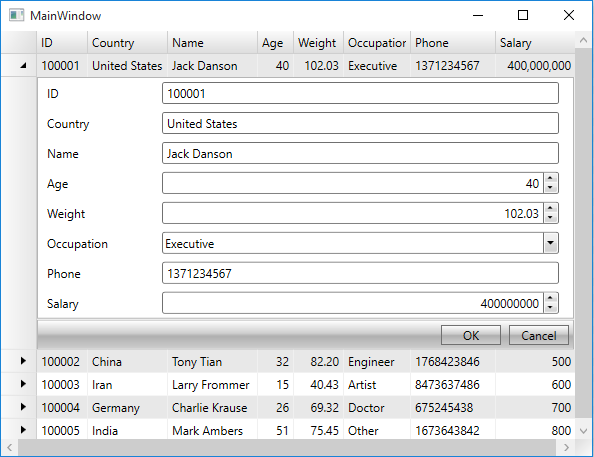InputPanel supports seamless integration with grid controls including MS DataGrid and ComponentOne's FlexGrid and DataGrid. These grid controls come with a baked-in data template, RowDetailsTemplate, which can be used to embed UI elements within a collapsible section for each row. Using this template, the InputPanel can be embedded to display the details of each row in a compact layout. You can interact with the template in XAML view, and set its binding in code to implement integration. In this section, we discuss how InputPanel can be integrated in FlexGrid control.
The following image shows an InputPanel integrated with a FlexGrid (C1FlexGrid).

To integrate InputPanel with ComponentOne FlexGrid
- Step 1: Set up the application
- Step 2:Create a data source
- Step 3:Integrate InputPanel with FlexGrid
Step 1: Set up the application
- Create a WPF application and add the InputPanel control onto the designer.
- Add C1.WPF.DataGrid dll in the References folder of your application.
- Initialize the RowDetailsTemplate of the grid in XAML view and set binding property as illustrated.
XAML Copy Code<c1:C1FlexGrid Name="flexgrid"> <c1:C1FlexGrid.RowDetailsTemplate> <DataTemplate> <c1:C1InputPanel CurrentItem="{Binding .}"/> </DataTemplate> </c1:C1FlexGrid.RowDetailsTemplate> </c1:C1FlexGrid>
Step 2: Create a data source
- Create a Customer class to add records into the InputPanel, and an enumeration to accept values for Occupation field.
- Switch to the MainWindow.xaml.cs file and add the following code to create a collection of records in the class constructor.
Step 3: Integrate InputPanel with FlexGrid
- To integrate the InputPanel with FlexGrid, set the ItemsSource property of the grid to the collection in the class constructor.
Similarly, you can integrate InputPanel with MS DataGrid and ComponentOne DataGrid using RowDetailTemplate property.
See Also